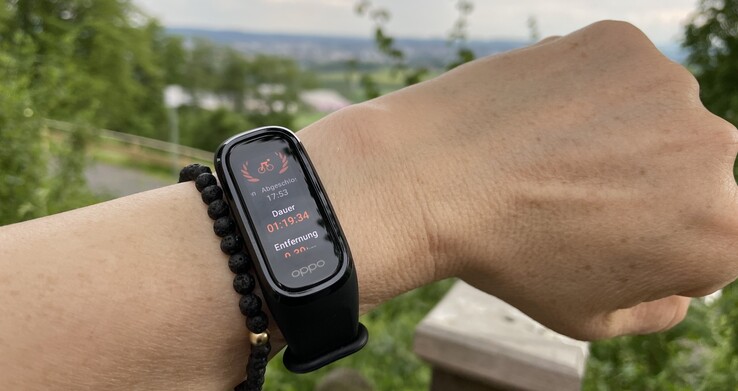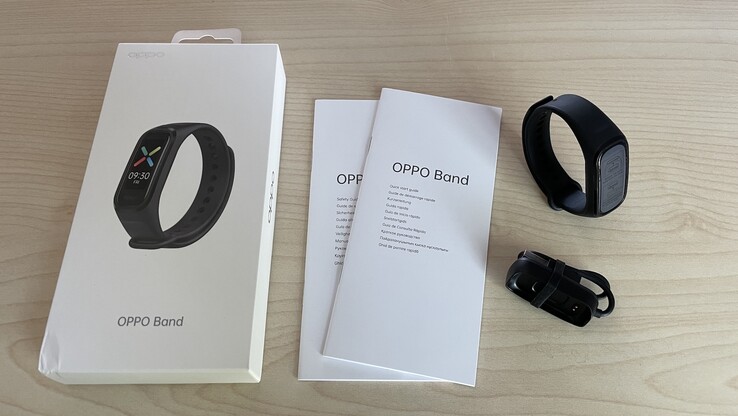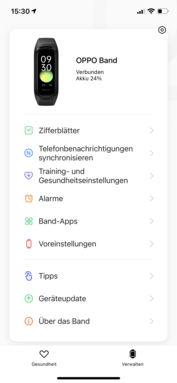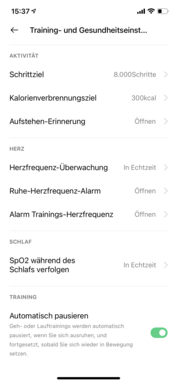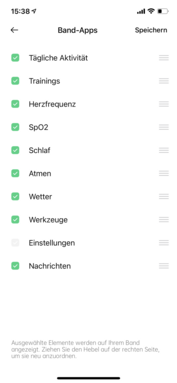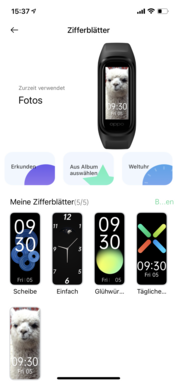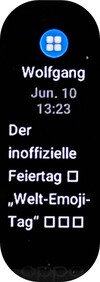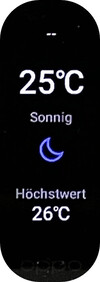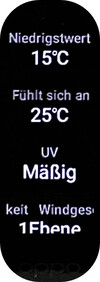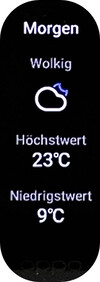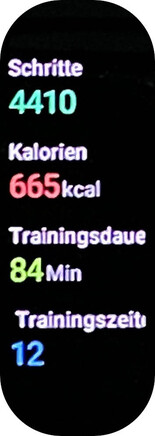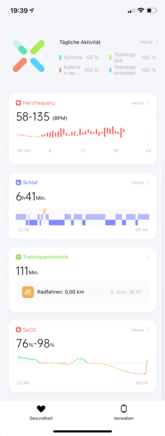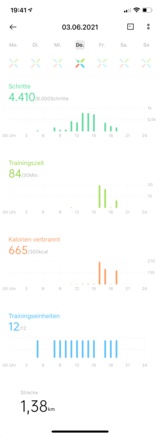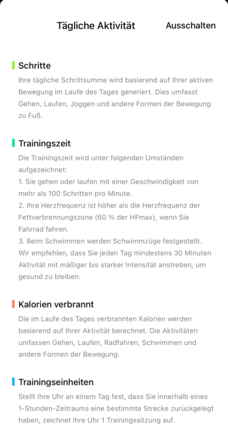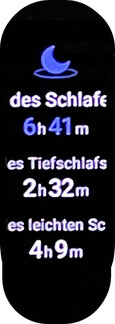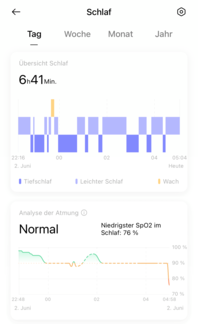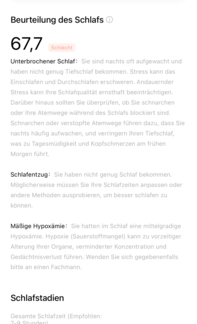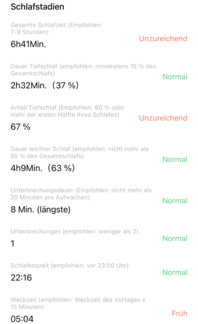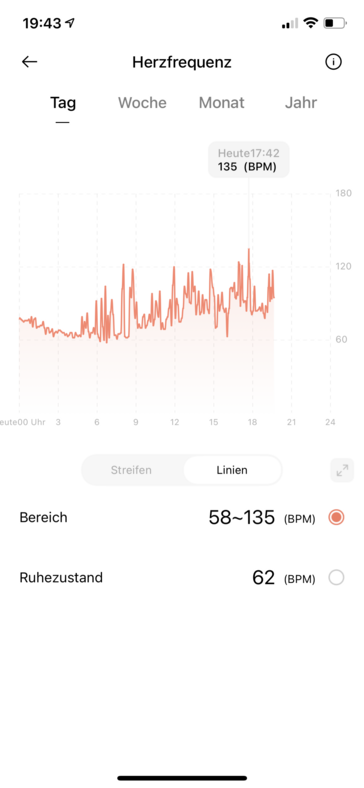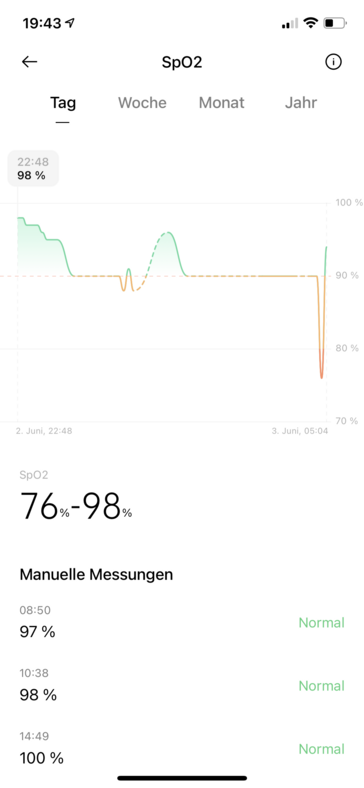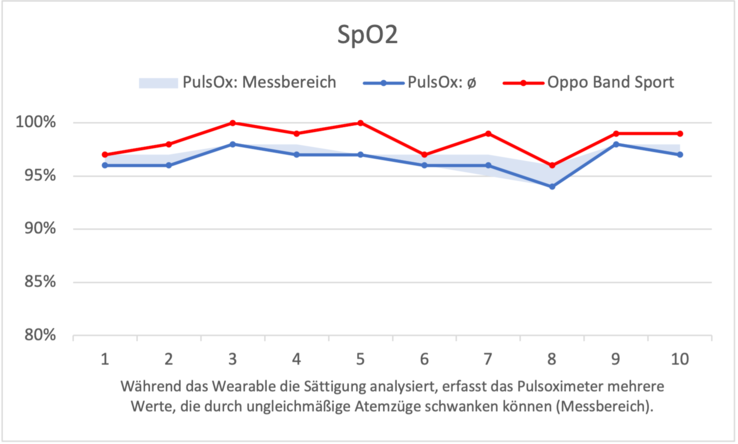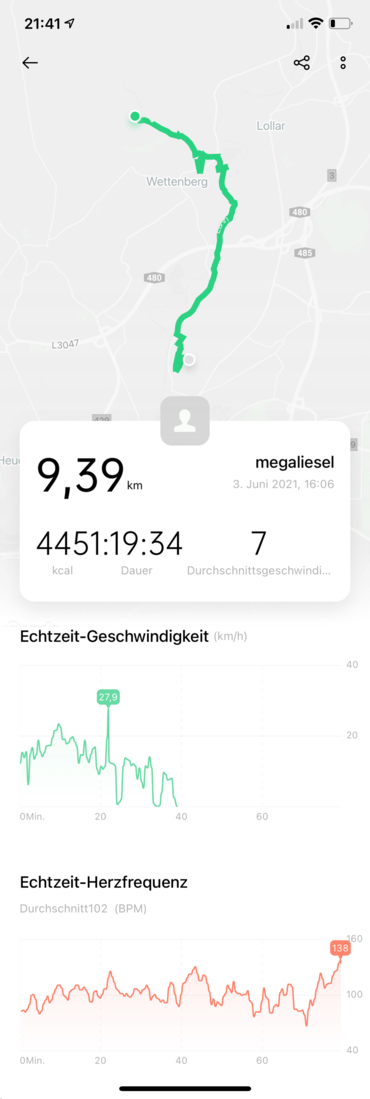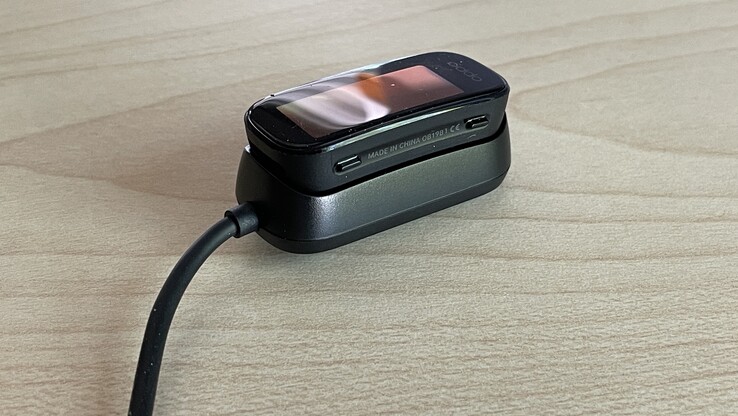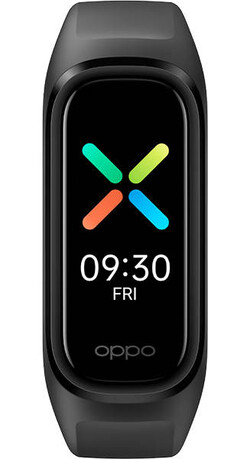Oppo Band Sport in review: The smart everyday companion emerges as an iffy fitness tracker
Case and equipment
Oppo manufactures its first fitness band in the style of recently tested fitness trackers, the Amazfit Band 5 and Mi Smart Band 6. The Oppo tracker can also be removed from the TPU band. Compared with the other two, however, it inserts level with the glossy plastic frame in the wristband, which looks nicer. The tracker weighs 23 g (~0.8 oz) with the band, just like the other two.
The polycarbonate casing is water resistant up to 5 ATM. An Apollo3 from Ambiq with 1 MB RAM works in the casing. The operating system, apps and installed watch faces share 16 MB.
The AMOLED display's resolution of 126 x 294 px is just as high as that of the Amazfit Band 5. With the same display diagonal of 1.1 inches, the pixel density of 291 ppi is also consistent. For comparison: The Mi Smart Band 6 has a resolution of 152 x 486 px on a diagonal of 1.56 inches and is clearly the winner in this respect. According to Oppo, the screen covers the DCI-P3 color space completely. The color space used in the film industry might not really seem necessary for a wearable, but it certainly cannot hurt if you immortalize your pet, boyfriend or girlfriend as the background - which is possible via the settings for the watch face.
The brightness does not regulate automatically, there are 5 levels to choose from for adjustment. Sensors include a 3-axis accelerometer and optical sensors for heart rate and blood oxygen saturation (SpO2).
Setup and operation
After loading, the band prompts to download the HeyTap app to connect to the smartphone. The ColorOS app is available in both the Playstore and Apple's App Store. The test was performed with an iPhone 12 Pro. During the setup, the user sets the parameters for health monitoring, determines the order of the apps on the band, and selects up to five watch faces from the Oppo Watchface Store or creates one from a custom photo. Oppo solves the issue of displaying a second time zone pragmatically: While an app has to be opened for this in Huami's Band 5 and the Xiaomi Band 6, Oppo also solves the issue of dual time via a watchface.
It is convenient that you can quickly switch between the watch faces by swiping horizontally. Oppo does not have the widgets that we know from other wearables. Regardless of the selected watch face, a quick tap on it opens a panel with information like battery level, do-not-disturb mode, and smartphone connection status. If the music player is currently active on the smartphone, Oppo automatically displays a shortcut for player control as seen on the screen at the bottom left.
Besides a smartphone search, stopwatch and timer, the tools include information about the weather with a two-day forecast. The remote controls for the smartphone's camera and music player worked with an Honor V20 and an iPhone 12 Pro in the test. Alarms are set on the smartphone and turned on or off on the wrist.
Telephony and notifications
The smartphone transmits incoming phone calls including the caller ID to the band. The calls can be rejected or the vibration of the band can be stopped, and the phone will continue to ring.
The band also shows slightly longer messages, but replaces emojis with block symbols. The band showed the associated app icon for WhatsApp messages, but not for messages from the messenger service Telegram.
Health and fitness
At Android, the HeyTap app connects to Google Fit. On the iPhone, it connects to Apple Health, but only transfers the steps there and in return reads the calorie consumption, which other apps may transfer to Apple Health.
The term "training units" in the daily log is misleading: It refers to hours during which the user was moving and not just sitting or lying down. Minutes with an increased heart rate, such as running or fast walking, are added up to training minutes and the steps and calories burned are also counted. However, the fitness tracker was not very accurate when it came to counting steps in the test: The Oppo Band Sport only counted 3602 steps out of 4000. At the same time, the Huawei Watch 3 counted a few more movements with 4005 steps, which is not unusual.
Sleep tracking
Oppo only differentiates between light and deep sleep phases. This is less detailed than manufacturers that also record the rapid eye movement (REM) phase. The latter normally accounts for a good 25% of the total sleep and is also called the dream phase.
If you activate the recording of oxygen saturation during sleep in the settings, you can also choose whether the band measures saturation in real time or at regular intervals as in the following recording. Recording in real time puts a much heavier load on the battery. The oxygen saturation graph highlights in color when saturation drops to 90% or below.
Heart rate, heart rhythm and blood oxygen saturation
We compare the blood oxygen saturation with the measurement result of a pulse oximeter in several runs. The Oppo Band Sport measures a higher saturation than the medically certified device in all 10 measurements. In the borderline range around 90%, a false higher value could lose the warning effect that normally comes from a result below 90%.
You can activate two heart rate alerts in the app's training and health settings: Oppo distinguishes a resting heart rate alert in everyday use and a higher limit during training. However, the optical heart rate monitor's precision is on a weak level especially during sports: We recorded a short interval workout with a heart rate monitor in parallel to examine the optical sensor's responsiveness. Between warm-up and cool-down, three intense training minutes alternate with longer breaks in which the heart rate drops again. The Oppo sensor hardly keeps up with the increasing frequency and only levels off again in the recovery phases when the heart rate stabilizes.
This is not a flaw for an inexpensive fitness band, but since Oppo offers an alarm for the training heart rate, it is important whether you can rely on it.
Training recording
There are 12 sports modes installed on the Oppo Band Sport. Besides running and cycling (indoors and outdoors), they include a fat-burn run, yoga, rowing and the elliptical trainer.
If you care about your pace, you'll have to take your smartphone with you when you run. Fitness trackers that don't have their own GPS, like the Oppo Band, estimate stride length based on height, age and weight, and determine a distance even if you leave your smartphone at home. Trackers like the Band 6 from Honor or Huawei do this quite well and are sometimes sufficient for recreational athletes. However, the Oppo Band Sport only managed 2.62 km (~1.6 mi) without a smartphone over a distance of 5.2 km (~3.2 mi) in the test. On the 2nd run, in conjunction with the smartphone and its GPS, the log also shows the route, vs Xiaomi's Mi Smart Band 6, but still comparatively few details. On the positive side, Oppo automatically pauses the log when you stop while walking or running.
The automatic pause detection does not work when cycling. In addition, the connection to the smartphone was interrupted during the cycling tour in the test, which is why the route recording ends prematurely.
Battery life
According to Oppo, the 100 mAh battery of the Band Sport lasts up to 12 days. In a test with several sports sessions and frequent activation of the display, the battery lasted almost 8 days.
The 100 mAh battery needs 1.5 hours to charge. To put it into the included charging cradle, you have to release it from the band with a bit of pressure.
Verdict
If you are looking for an everyday companion with nice features without high demands, you will get a nice wearable in the Oppo Band Sport that allows you to control the smartphone's music and camera, see weather information, and much more. The sleep log distinguishes fewer sleep phases than usual, but indicates when the saturation has dropped below the threshold of 90% during the night.
The fact that widgets are missing and horizontal gestures change the watch face instead initially caused skepticism in the test. In practice, however, the watch face changed surprisingly often, depending on the outfit and mood.
The Oppo Band Sport's app and interface appear clear and well-organized.
However, the Oppo Band cannot shine as a running and cycling tracker. The step counter shows a comparatively high deviation of about 10%. The PPG sensor does not follow the interval workout like a Sports watch from Polar. This is not surprising and is not expected from a simple tracker. We occasionally experience disconnections in other fitness trackers without their own GPS and they are not necessarily the tracker's fault. However, Oppo's use of the data is meager. Xiaomi shows that even a simple fitness band can deliver more in combination with the software with its Mi Smart Band 6. Xiaomi sets the price a bit lower at 44.99 Euros (~$54.50). Online retailers like Amazon offer it a bit cheaper.
Price and availability
At market launch, the Oppo Band Sport was only available in black and exclusively at Amazon for 49 Euros (~$59.35). The price remained unchanged until the end of testing.




